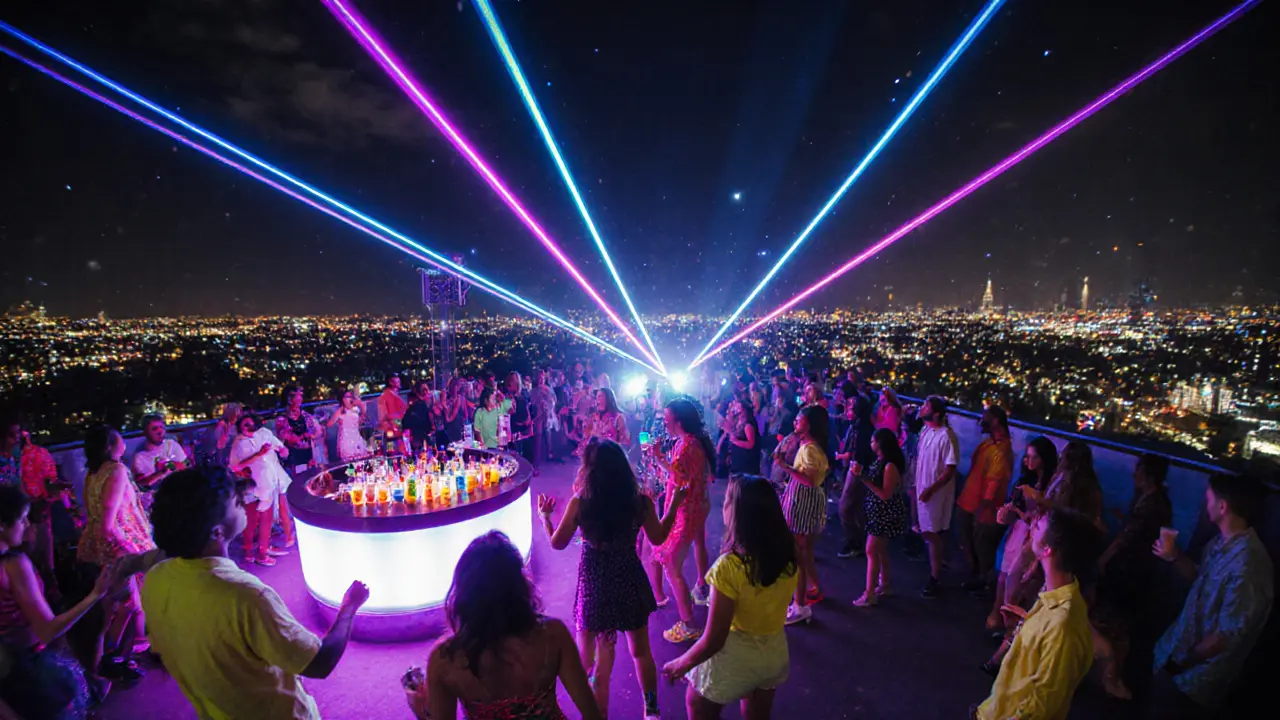Key Takeaways
- Start with a clear theme and guest list before booking anything.
- Create a 8‑week timeline that breaks down every major task.
- Allocate 40% of your budget to food and drinks, 30% to venue, and the rest to décor and entertainment.
- Use a simple spreadsheet to track spend and avoid surprise costs.
- Decide early whether you’ll DIY or hire a professional - the comparison table helps.
Direct Answer
If you want to throw a party people still talk about months later, focus on three pillars: a tight guest list, a memorable theme, and a realistic budget. Map out tasks on a timeline, lock down venue and catering early, and sprinkle in unique entertainment that fits your vibe. Follow the step‑by‑step guide below and you’ll have a legendary bash without the panic.
Comprehensive Guide to Hosting a Legendary Bash
Picture this: the lights are dim, the music is just right, guests are laughing, and everyone’s Instagram feeds are buzzing with photos of your party. Sounds like a dream, right? The good news is that with a solid plan, that dream can become reality - and you won’t be pulling your hair out in the process.
Definition and Context
Party Planning is a process that involves organizing every detail of an event - from guest list to cleanup - to create a cohesive, enjoyable experience for attendees. Whether you’re celebrating a birthday, a promotion, or just because the weekend feels right, good planning turns chaos into a smooth flow. In 2024, the average house party cost $1,200, while a well‑executed themed event can easily exceed $3,000 - but the payoff in memories (and social media clout) is priceless.
Benefits of Throwing a Legendary Bash
Why does a legendary bash matter? First, it leaves a lasting impression that strengthens friendships and networks. Second, a well‑run party reduces stress for the host - no last‑minute scrambles. Third, it gives you the chance to showcase creativity, whether through an eye‑catching theme, unique cocktail, or interactive entertainment.
Core Elements of a Legendary Bash
Below are the eight building blocks you’ll need to master. Each gets its own microdata definition the first time it appears, so you’ll know exactly what to focus on.
Guest List is a curated group of invitees whose interests, size, and relationship to the host guide venue size, food quantity, and overall vibe. Start with a rough count, then trim or expand based on your budget and venue capacity.
Theme is a central idea that ties décor, music, dress code, and activities together, creating a memorable visual and emotional thread. Popular 2025 themes include neon rave, tropical escape, and retro 90s.
Venue is a physical location - from a living room to a rooftop bar - that accommodates the guest list, supports the chosen theme, and meets any legal noise or capacity limits. Book early; many venues require a deposit 4-6 weeks ahead.
Catering is a service that provides food and beverages, ranging from a simple snack board to a full‑service dinner. Decide on a menu that matches the theme and aligns with dietary restrictions.
Entertainment is a activity or performance that engages guests, such as a DJ, live band, photo booth, or interactive games. The right entertainment fills gaps in the timeline and keeps energy high.
Budget is a financial plan that allocates funds across venue, food, décor, entertainment, and contingency, preventing overspend. Use percentages as a quick rule‑of‑thumb (see Budget Planning Tips below).
Timeline is a chronological schedule that outlines when each planning task should be completed, from invitations to post‑party cleanup. A solid timeline keeps you on track and reduces last‑minute stress.
Other supporting elements include Decorations and Music Playlist, which add personality but fit within the larger framework.
Step‑by‑Step Timeline (8‑Week Plan)
- Week8-7: Choose a theme, set a date, draft a preliminary guest list, and lock in the venue.
- Week6: Send “Save the Date” messages, start a budget spreadsheet, and research catering options.
- Week5: Finalize the guest list, confirm catering menu, and book entertainment.
- Week4: Order décor, create a music playlist, and order any special equipment (e.g., lighting, photo booth).
- Week3: Send formal invitations with RSVP deadline, purchase party supplies, and double‑check contracts.
- Week2: Follow up on RSVPs, finalize headcount, and confirm delivery times for food and décor.
- Week1: Prepare a layout map of the venue, set up a cleaning station, and run a quick sound check.
- DayOf: Arrive early, set up décor, test lighting, greet guests, and enjoy the party!
Budget Planning Tips
Start with a master spreadsheet. Create columns for “Category,” “Planned Cost,” “Actual Cost,” and “Notes.” Populate with these typical percentages:
- Venue: 30% of total budget
- Catering & Drinks: 40%
- Entertainment: 15%
- Decor & Rentals: 10%
- Contingency (unexpected fees): 5%
Adjust the percentages based on what matters most to you - maybe you’d spend more on a live band and less on décor. The key is to track every invoice; a 5% overrun is usually manageable, but a 20% surprise can kill the vibe.

DIY vs. Professional Planner: Which Works Best?
| Aspect | DIY Approach | Professional Planner |
|---|---|---|
| Cost | Lower upfront (you pay for services only) | Higher upfront fee (10‑15% of total budget) |
| Time Investment | Significant - you handle everything | Minimal - planner manages schedule |
| Creativity Control | Full control over theme and décor | Planner offers expertise, may suggest compromises |
| Stress Level | Higher - many moving parts | Lower - planner handles logistics |
| Vendor Access | Standard rates, limited discounts | Industry connections, possible discounts |
If you love hands‑on projects and have a tight budget, DIY is rewarding. If you’d rather relax and guarantee flawless execution, hiring a planner is worth the premium.
Safety and Legal Checklist
- Check local noise ordinances - many cities enforce quiet hours after 11pm.
- Verify venue capacity limits and fire safety exits.
- Provide non‑alcoholic options for guests who don’t drink.
- If serving alcohol, consider a licensed bartender to avoid liability.
- Have a basic first‑aid kit and designate a sober contact.
Frequently Asked Questions
How far in advance should I send invitations?
Send a “Save the Date” at least 8 weeks before the event, then follow up with formal invites 4 weeks out. This gives guests time to clear their schedules and RSVP.
What’s a realistic budget for a 50‑guest party?
For 50 guests, a $2,500-$3,500 budget is typical. Allocate roughly $1,200 for food & drinks, $900 for venue, $400 for entertainment, and the rest for décor and contingency.
Do I need a permit for outdoor music?
Many municipalities require a temporary event permit if you exceed a certain decibel level or use amplified sound. Check your city’s parks department website and apply at least two weeks ahead.
How can I keep guests entertained without a DJ?
Create a collaborative playlist on Spotify and let guests add songs ahead of time. Pair it with a simple Bluetooth speaker, and you’ll have a crowd‑sourced soundtrack that feels personal.
What are some quick DIY décor ideas?
String fairy lights across walls, use mason‑jar candle holders, and print themed labels for bottled drinks. All of these cost under $20 and look polished.
Next Steps
Grab a notebook or open a spreadsheet, pick a theme that excites you, and start ticking off the timeline above. Remember, the goal isn’t perfection; it’s creating a night that feels unforgettable for you and your guests. Ready to start planning? Dive in now and make that legendary bash happen!






Lizzie Fieldson
Honestly this whole party planning hype is just a waste of time
Shannon Gentry
Yo i totally feel ya the vibe of a themed bash can be sooo lit its like paintin a canvas with music
just make sure the guest list isn't too bloated cause that kills the vibe and make the space feel cramped
i love the 8‑week timeline idea it keeps everything on point and less stressful
Rebecca Putman
Sounds awesome! 😄 I cant wait to try the 8‑week plan and make my friends go wow